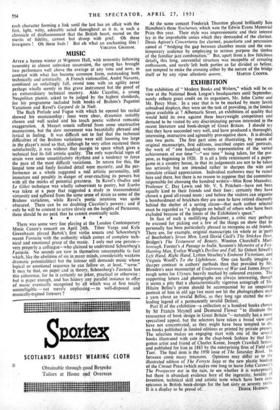EXHIBITION
THE exhibition of " Modern Books and Writers," which will be on view at the National Book League's headquarters until September. surely reflects great credit on its organisers, Mr. John Carter and Mr. Percy Muir. In a year that is to be marked by many lavish subsidised displays, they were set the task of providing, in the limited space available at 7 Albemarle Street, an exhibition of quality that would hold its own against these heavyweight competitors and demand to be visited by any discriminating person interested in the recent literature and book-design of Great Britain. I should say that they have succeeded very well, and have produced a thoroughly interesting, instructive and agreeably pros Native show. It is divided into two parts. The first part aims at illustrating, by means of original manuscripts, first editions, inscribed copies and 'portraits. the work of " one hundred writers representative of the varied achievement of our time "—" our time " being taken, for the pur- pose, as beginning in 1920. It is all a little reminiscent of a paper- game in a country house, in that its judgements are not to be taken too seriously but are intended rather to sharpen the wits and stimulate critical appreciation. Individual eyebrows may be raised here and there, but there is no reason to suppose that the committee responsible for choosing the hundred writers—Miss Rose Macaulay, Professor C. Day Lewis and Mr. V. S. Pritchett—have not been equally kind to their friends and their foes ; certainly they have chosen a good all-round team ; and before the visitors can organise a bombardment of brickbats they are seen to have retired discreetly behind the shelter of a saving clause—that each author selected must be regarded as " a delegate on behalf of others who have been excluded because of the limits of the Exhibition's space."
In face of such a mollifying disclaimer, a critic may perhaps be excused for picking out a few of the things on show that he personally has been particularly pleased to recognise as old friends. There are, for example, original manuscripts (in whole or in 'part) of Beerbohm's Seven Men, Lord David Cecil's The Stricken Deer, Bridges's The Testament of Beauty. Winston Churchill's Marl- borough, Forster's A Passage to India, Sassoon's Memoirs of a Fox- Hunting Man, Evelyn Waugh's Decline and Fall, Sir Osbert Sitwell's Left Hand, Right Hand, Lytton Strachey's Eminent Victorians, and Virginia Woolfs To the Lighthouse. One can hardly imagine a sharper contrast in authors' methods than that provided by Mr. Blunden's neat manuscript of Undertones of War and James Joyce's rough notes for Ulysses, heavily marked by coloured crayons. The supporting letters and photographs are always interesting, though it seems a pity that a characteristically vigorous autograph of Mr. Hilaire Belloc's prime should be accompanied by an unsparing portrait of him in old age (we must not let the photographers start a yarn about an invalid Belloc, as they long ago started the mis- leading legend of a permanently invalid Delius).
Part Ii of the exhibition—a collection of a hundred books chosen by Sir Francis Meynell and Desmond Flower "to illustrate the renascence of book design in Great Britain "—naturally has a more specialised appeal, but the selectors have taken a broad view and have not concentrated, as they might have been tempted to do, on books published in limited editions or printed by private presses. The selection makes an engaging start with one of the several books illustrated with cuts in the chap-book fashion by that for- gotten artist and friend of Charles Keene, Joseph Crawhall Senior. and published for him in 1883 by the enterprising firm of Field and Tuer. The final item is the 1950 issue of The Saturday Book. In between come many treasures. Opinions may differ as to the illustrated edition of The Forsyte Saga or the new plastic binding of the Cresset Press (which makes one long to leave John Carsweils The Prospector out in the rain, to see whether it is waterproof ). but there is abundant evidence here of the ingenuity, fertility of invention, technical skill and artistic taste which have been con- spicuous in British book-design for the last sixty or seventy years.


































 Previous page
Previous page